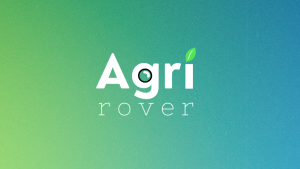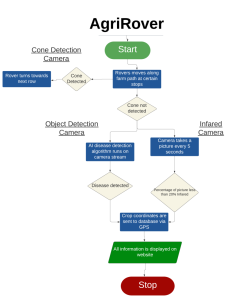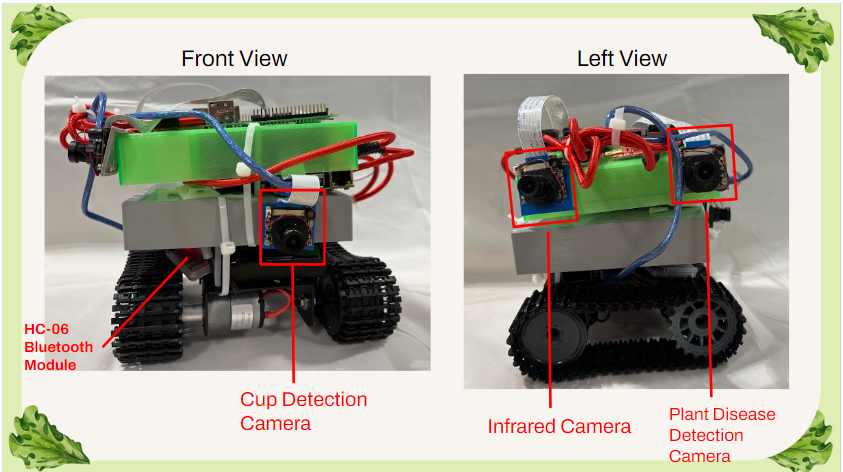
Abstract
Every year, $220 billion worth of crops are lost to plant diseases every year, and existing solutions pose additional threats to human and natural life. There are few solutions for this issue, and the ones that exist require a lot of human involvement (such as an app that can diagnose plants by taking a picture of them). We wanted to create a solution that tackled the problem of fast, reliable diagnosis of crops that also supported our beliefs of feeding people safely and sustainably. Our solution, AgriRover, is an autonomous system that is able to detect diseased/dying crops and pinpoint the locations of these crops to farmers. We used infrared cameras that would measure the infrared light coming off plants in order to measure how healthy they were, and regular cameras with an AI model processing the feed in order to determine if plants had diseases. AgriRover then marks the location of diseased or unhealthy plants using a GPS. These coordinates are then mapped onto a web app that farmers can access in order to see where there are diseased or dying crops in their fields and can take action. We hope that with this solution, we can automate the detection of diseased plants for farmers all around the world and prevent the spread of diseases that destroy their harvests, helping fight against world hunger.
Problem Statement
On average, plant diseases have reduced farmers’ yield to about 70%. Every year, $220 billion worth of crops are lost to diseases, enough to end world hunger 5 times over. The solutions are pesticides and herbicides, which have been shown to cause Celiac disease and many other health issues. Thus, we set out on creating an autonomous system that could detect diseased/dying crops and pinpoint the locations of these crops to farmers.

Ideation Phase
We used an AI tool called ChatGPT to pinpoint the problem we wanted to address. We also used the AI to find the code and commands needed to program our rover and its computers. This was very helpful in starting off projects and gave us good ideas about where to go with our project.
We considered outfitting the rover with the ability to spray paint on the ground where the diseased plant was. This would help us be able to locate the plant faster. We decided against this because not only could the paint be toxic but it would also be very heavy and bulky. Instead we decided to invest in an accurate GPS to pinpoint the location of the diseased/unhealthy plant.
Design Criteria:
- Autonomous system to detect common diseases among crops
- Long and consistent battery life
- Consistent performance through varying weather conditions
- Log locations of diseased/dying plants
Design Alternatives and Ranking
We chose to create a rover rather than a drone due to the overall durability and cost-effectiveness of the rover and its functions, given the time frame of this program.
Rover
- Pros:
- Can get up close to plants; accurate readings
- More durable and longer battery life
- Less complex and expensive to create
- Cons:
- Is limited to only fields where crops are ordered in rows
Drone
- Pros:
- Able to operate in different field layouts; not limited to rows
- Cons:
- Low durability, low battery life
- Cannot easily get up close to plants and read accurately
- More complex to create, harder navigation code
Testing + Final Design
Our design consisted of different parts to perform different roles
- Our main chassis, consisting of motors and treads to move around
- An arduino (mini-controller) to control these motors
- Raspberry Pis (mini-computers) to handle vision processing
- Cameras to record plant in regular and infrared light
- A GPS module to locate where diseased/dying plants are
A core part of our project was the disease detection system. It used an infrared and normal camera that connected to Raspberry Pi’s (mini computers).
- The infrared camera would capture the infrared light reflecting off the plant to determine how healthy it was.
- The regular camera was connected to a trained AI model that would detect different diseases in plants.
- We collected a dataset of images of diseased plants with labels corresponding to what disease they had. We then trained an AI model that would learn how to classify which plants had diseases over time. At the end of the training process, we had a model that could look at different plants and determine certain diseases they might have
- Another part of the project was the mobility and navigation of the rover. This required an Arduino computer and motor driver connected to a set of motors and treads
- A camera on the rover connected to another AI model would look for a marker (cone) to simulate reaching the end of a row of crops and knowing when to turn into the next row

- The third component was the GPS module. We connected a Raspberry Pi to a GPS module and got a strong satellite connection using an external antenna which tracked the RPi’s location down to three feet.
- If the cameras located a diseased or unhealthy plant, the GPS module would mark the location this plant.
- The last component was data transfer. Once the diseased/unhealthy plant was marked, this data had to be displayed on a map that the user could view on a webapp. We accomplished this by storing the GPS coordinates and sending them to a cloud database (Firebase), this database would then be read by our webapp and display the coordinates on a map.
Shown below are the labeled images of our final rover design:
Project Video
Conclusion
We created a rover that could autonomously detect diseased/dying plants utilizing AI and vision processing models along with a second AI model to handle navigation. We also implemented a GPS-to-Webapp communication system that could visualize the coordinates of diseased plants on a map. We fulfilled all our design criteria, and are excited about the potential of this solution to impact world hunger
Limitations
- Small size will prevent it from diagnosing tall plants such as cornstalk
- The Raspberry Pi may be slow when running the software, requiring the use of a hardware accelerator
- The rover is limited to fields with crops in organized rows
- Extreme weather conditions will still limit the performance of the robot
Moving Forward
A project like this needs to be properly tested, and unfortunately we did not get the opportunity to extensively test this product in a field of crops, which is something we would like to do in the future.
References and Works Cited
Alarcon, Nefi. “Startup Uses AI to Identify Crop Diseases With Superb Accuracy | NVIDIA Technical Blog.” NVIDIA Developer, 4 April 2018, https://developer.nvidia.com/blog/startup-uses-ai-to-identify-crop-diseases-with-superb-accuracy/. Accessed 27 July 2023.
“Capture plant health with NDVI and Raspberry Pi | Coding projects for kids and teens.” Raspberry Pi, https://projects.raspberrypi.org/en/projects/astropi-ndvi. Accessed 27 July 2023.
“examples/lite/examples/object_detection/raspberry_pi/README.md at master · tensorflow/examples.” GitHub, https://github.com/tensorflow/examples/blob/master/lite/examples/object_detection/raspberry_pi/README.md. Accessed 27 July 2023.
“Farmaid: Plant Disease Detection Robot.” Hackster.io, 30 October 2018, https://www.hackster.io/teamato/farmaid-plant-disease-detection-robot-55eeb1. Accessed 27 July 2023.
Fernandez, Jorge, et al. “Pesticide Use Peaked in 1981, Then Trended Downward, Driven by Technological Innovations and Other Factors.” USDA ERS, 2 June 2014, https://www.ers.usda.gov/amber-waves/2014/june/pesticide-use-peaked-in-1981-then-trended-downward-driven-by-technological-innovations-and-other-factors/. Accessed 27 July 2023.
Nemire, Brad. “NVIDIA Researchers Release Trailblazing Deep Learning-Based Framework for Autonomous Drone Navigation | NVIDIA Technical Blog.” NVIDIA Developer, 7 September 2017, https://developer.nvidia.com/blog/nvidia-researchers-release-trailblazing-deep-learning-based-framework-for-autonomous-drone-navigation/. Accessed 27 July 2023.
Norris, Will. “Using Panel to Build Data Dashboards in Python.” Towards Data Science, 11 August 2022, https://towardsdatascience.com/using-panel-to-build-data-dashboards-in-python-e87a04c9034d?gi=111b15c75831. Accessed 27 July 2023.
Meet the Team
Click on our icons below to learn more about us.
Infrared detection algorithm, Cup detection algorithm, GPS to Website(Firebase, JupyerLab, Web application), deployment of AI Disease Detection
GPS system, Portfolio Website, Rover design, Rover building
AI training software, deployment of AI Disease Detection, deployment of Cup detection, Portfolio Website
3D models, building of Rover, Rover Driving mechanism













